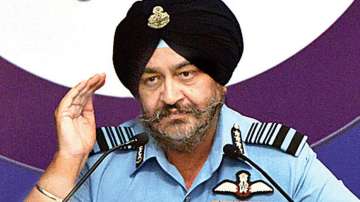He said in case "we have correct coordinates, the Air Force is capable of doing all-weather bombing through clouds".
Early this year, after the Pulwama terror attack that killed 40 CRPF personnel, the Air Force launched airstrikes at a terror camp in Balakot, inside Pakistani territory.
Speaking at a seminar on '20 years of Op Safed Sagar', Dhanoa said precision bombing capability was very much needed during the Kargil operations where targets were very small and at high altitudes.
"In 1999 (precision bombing capabilities) was operationalised only on the Mirage-2000 aircraft. Now all aircraft, Mirage, Su-30, Jaguar, MiG-29 and MiG-27 upgraded aircraft have the capability for precision bombing. Not only that, in case we have correct coordinates we can do all-weather bombing through clouds very accurately," Dhanoa said.
"We have just seen in the attack that we carried out on February 26 that we are capable of a precision strike from standoff distances and very accurately," he added.
ALSO READ: WATCH: IAF Chief BS Dhanoa carries out solo sortie on MIG-21 aircraft
Dhanoa, who was then the Commanding Officer of 17 Squadron and operating from Srinagar, recalled the air action that took place during the Kargil conflict.
It was for the first time that the MiG-21 aircraft carried out the air-to-ground bombing at night in the mountains, he said.
Operation Safed Sagar was carried out by the Air Force in Operation Vijay to drive out infiltrators from Kargil.
Dhanoa spoke about the operational limitations that existed in 1999 and the innovative ways adopted by the IAF to overcome the difficulties during the conflict.
He also pointed out the non-availability of winter-clothing and "big intelligence gaps" during the Kargil operations.
"We had no (winter clothing)... I want to emphasis that point. Winter clothing was authorised to units that were flying over Siachen. Rest of us did not have this clothing. We had our summer overalls and the woollen inner. We used to wear two of them," Dhanoa said.
The developments which took place post Kargil war have transformed the Air Force in capability so as to counter any kind of air threat in conventional and sub-conventional domains of warfare, he said.
"Over a period of time, the Air Force has evolved in a manner that we have through a process of long our long planning and induction. Slowly, we got our ability to take part in operations across the spectrum of the conflict. It is now a force that is capable of full-spectrum conflict, from sub-conventional to nuclear," the Air Force Chief said.
At present, BVR (beyond-visual-range) missiles are carried by MiG-29, Su-30 and Mirage-2000 aircraft.
The IAF has the Airborne Warning and Control System (AWACS) aircraft to monitor the airspace deep inside the enemy territory and operates on secure communication with network-centric warfare capabilities, he said.
ALSO READ: Will go into AN-32 aircraft crash, ensure it does not happen again: IAF chief BS Dhanoa
WATCH VIDEO: Air Force Chief Air Chief Marshal BS Dhanoa is visiting Air Force Station Jorhat in Assam
Latest India News
